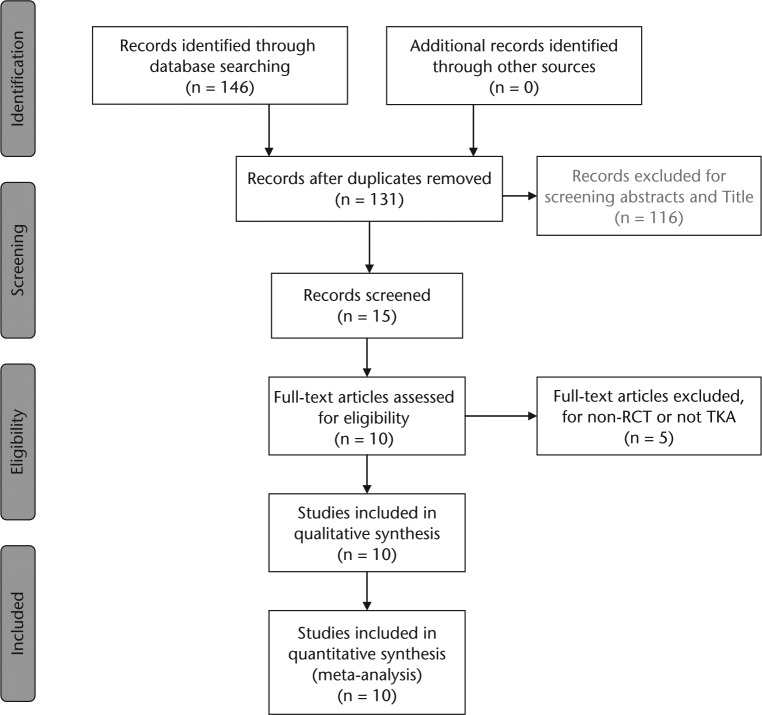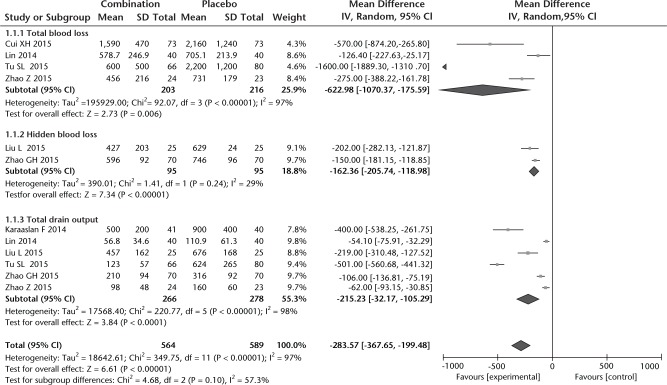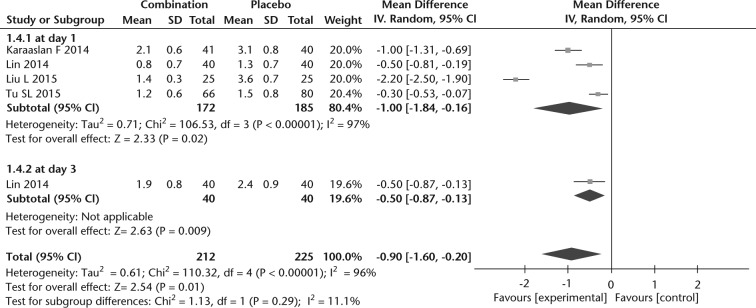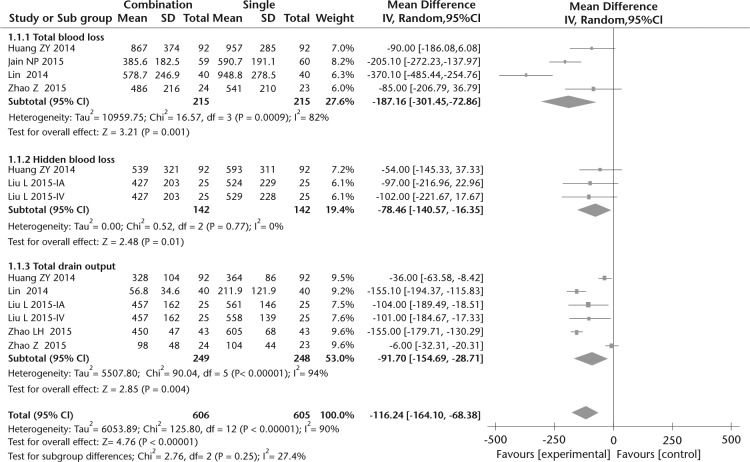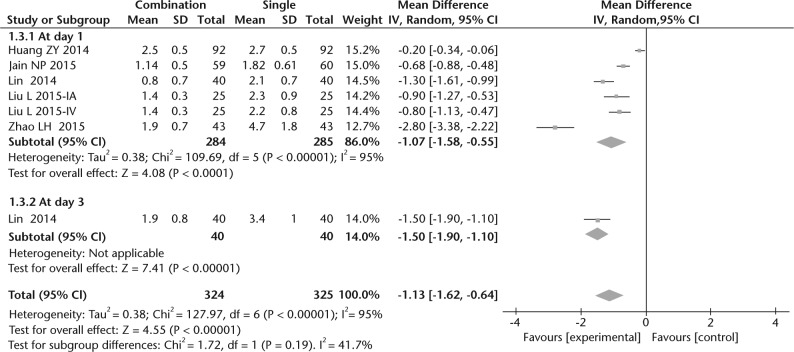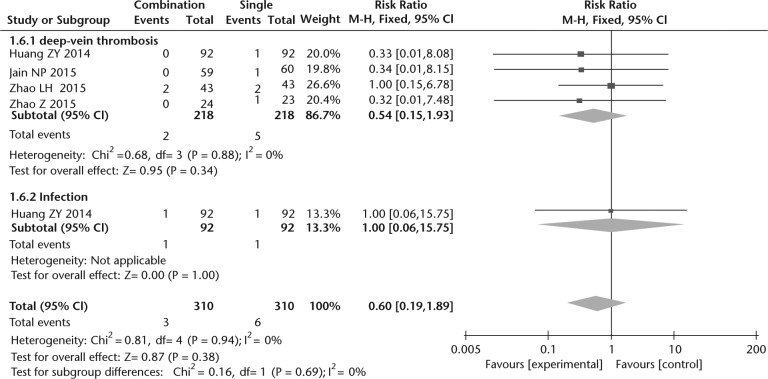Abstract
Objectives
Tranexamic acid (TXA) is an antifibrinolytic agent used as a blood-sparing technique in total knee arthroplasty (TKA), and is routinely administered by intravenous (IV) or intra-articular (IA) injection. Recently, a novel method of TXA administration, the combined IV and IA application of TXA, has been applied in TKA. However, the scientific evidence of combined administration of TXA in TKA is still meagre. This meta-analysis aimed to investigate the efficacy and safety of combined IV and IA TXA in patients undergoing TKA.
Materials and Methods
A systematic search was carried out in PubMed, the Cochrane Clinical Trial Register (Issue12 2015), Embase, Web of Science and the Chinese Biomedical Database. Only randomised controlled trials (RCT) evaluating the efficacy and safety of combined use TXA in TKA were identified. Two authors independently identified the eligible studies, extracted data and assessed the methodological quality of included studies. Meta-analysis was conducted using Review Manager 5.3 software.
Results
A total of ten RCTs (1143 patients) were included in this study. All the included studies were randomised and the quality of included studies still needed improvement. The results indicated that, compared with either placebo or the single-dose TXA (IV or IA) group, the combination of IV and IA TXA group had significantly less total blood loss, hidden blood loss, total drain output, a lower transfusion rate and a lower drop in haemoglobin level. There were no statistically significant differences in complications such as wound infection and deep vein thrombosis between the combination group and the placebo or single-dose TXA group.
Conclusions
Compared with placebo or the single-dose TXA, the combined use of IV and IA TXA provided significantly better results with respect to all outcomes related to post-operative blood loss without increasing the risk of thromboembolic complications in TKA.
Cite this article: Z. F. Yuan, H. Yin, W. P. Ma, D. L. Xing. The combined effect of administration of intravenous and topical tranexamic acid on blood loss and transfusion rate in total knee arthroplasty: combined tranexamic acid for TKA. Bone Joint Res 2016;5:353–361. DOI: 10.1302/2046-3758.58.BJR-2016-0001.R2.
Keywords: Total knee arthroplasty, Tranexamic acid, Combination
Article focus
This meta-analysis of randomised controlled trials aimed to investigate the efficacy and safety of combined intravenous (IV) and intraarticular (IA) TXA in patients undergoingTKA.
Key messages
Compared with either placebo or single dose TXA (IV or IA) group, combination use of IV and IA TXA group had significantly less total blood loss, hidden blood loss, total drain output, transfusion rate and lower drop of haemoglobin level.
Besides, there were no statistical differences in complications, including wound infection and deep vein thrombosis between combination group and placebo or single dose TXA group.
Strengths and limitations
To our knowledge, this is the first comprehensive meta-analysis to evaluate the efficacy and safety of combined regimen of TXA in TKA.
This meta-analysis included only randomised controlled trials, which provided high-level evidence for clinical practice.
Third, the preferred reporting items for systematic review and meta-analysis statement was applied in this study, ensuring the quality of meta-analysis.
Introduction
Total knee arthroplasty (TKA) is one of the most successful orthopaedic procedures indicated for end-stage osteoarthritis and other joint diseases of the knee. However, TKA is associated with significant blood loss. It is estimated that primary TKA can result in a post-operative loss of up to 2000 mL.1 Thus, TKA often requires blood transfusion and the transfusion rate ranges from 11% to 21% during TKA.2 Blood transfusions are associated with increased risks of immunological reactions, infection, alloimmunisation, transfusion-related acute lung injury and 90-day mortality.3
Many strategies have been developed for the management of peri-operative blood loss, including pre-operative autologous blood donation, various blood salvage techniques, careful haemostasis and the use of antifibrinolytic agents.4 In recent years, tranexamic acid (TXA) has been widely used in orthopaedic surgery. TXA is a synthetic drug that reduces blood loss through inhibition of fibrinolysis and clot degradation.5 Currently, various dosing regimens have been used for TXA, including intravenous (IV), intra-articular (IA) and oral forms.6 High quality evidence from systematic reviews and meta-analyses7,8 have confirmed the efficacy of IV TXA and IA TXA in TKA. Recently, a new method, the combined use of IV TXA and topical TXA has been used in orthopaedic surgery.9-18 However, the scientific evidence of combining IV and topical TXA in TKA is still meagre.
Thus, the aim of this meta-analysis was to identify all available randomised controlled trials (RCTs) to assess the efficacy and safety of the combined use of IV and IA TXA during TKA. This meta-analysis was designed mainly to discuss the following three questions: Is the combined application of TXA associated with less blood loss compared with placebo? Is the combined application of TXA superior to single-dose (IV or IA) TXA for reducing blood loss? Does the combined application of TXA increase the risk of thromboembolism complications compared with placebo or single-dose TXA?
Material and Methods
Search strategy
This meta-analysis was conducted according to the preferred reporting items for systematic review and meta-analysis (PRISMA) guidelines.19 A comprehensive literature search was performed in the following databases: PubMed (search from 1966 to December 2015), the Cochrane Clinical Trial Register (December 2015), Embase (1974 to December 2015), Web of Science (1956 to December 2015) and the Chinese Biomedical Database (1978 to December 2015). The literature search was restricted to studies published in English and Chinese. With the assistance of a librarian, the search terms included: tranexamic acid; TXA; combin*; knee; arthroplasty; replacement; and randomised controlled trials (RCTs). In addition, the reference lists of retrieved studies and relevant reviews were also manually checked for additional publications.
Inclusion criteria
Papers were included if they met the following criteria: the design was a RCT; patients undertook primary TKA surgery; the control group was placebo, IV TXA or IA TXA; studies reported at least one outcome of our meta-analysis.
The primary outcomes assessed in this meta-analysis were blood loss (total blood loss, hidden blood loss and total drain output), transfusion rate and the drop in haemoglobin (Hb) level. The secondary outcomes were length of hospital stay and complications (deep vein thrombosis, infection and wound complications).
Data extraction and risk of bias
Data extraction was conducted by two independent reviewers using a standard data extraction table. The following data were extracted from all eligible studies: study design; sample size; age; the dose of TXA in the combined group; surgical approach; and outcomes reported.
The methodological quality of each component study was assessed with the use of the Cochrane Reviewer’s Handbook 5.1 for risk of bias.20 The items included were the adequacy of randomisation, allocation concealment, blinding, incomplete outcome data (attrition bias), selective reporting (reporting bias) and other bias.
Statistical analysis
Risks ratio (RRs) with their corresponding 95% confidence intervals (CIs) were generated for dichotomous data (transfusion rate, deep vein thrombosis, infection and wound complication) and mean differences (MDs) with 95% CIs were converted to continuous outcome data (blood loss, drop in Hb and length of hospital stay). To estimate the heterogeneity among studies, we calculated I2 values and Cochrane Q statistics (with significance level of p-value < 0.1). In the presence of homogeneity (I2 < 50%), the fixed effects model was used to estimate the overall effects. If there was significant heterogeneity among included studies, the random effects model was used. The meta-analysis was undertaken using RevMan 5.3 software (The Cochrane Collaboration, Oxford, United Kingdom).
Results
Search results
A flow diagram for the study selection is shown in Figure 1. Our systematic search identified 146 potentially relevant studies. Of those, 15 were excluded as they were discovered to be duplicates when checked through Endnote software. Of the remaining 131 studies, 116 publications were scanned by reading the title and abstract. This process yielded 15 reports for full-text review. Of these, ten RCTs9-18 fulfilled the inclusion criteria and were available for this meta-analysis. No additional publications were identified from manually searching the reference lists of retrieved studies and relevant reviews.
Fig. 1.
The Preferred Reporting Items for Systematic Reviews and Meta-Analyses flowchart of study screening and exclusions
Characteristics of included studies
The characteristics of the included trials are summarised in Table I. A total of 1143 patients were randomised in the ten included RCTs (Table I). Of those, 532 patients were randomised to combination treatment, 287 patients to the single-dose treatment and 324 patients to placebo. Sample sizes of individual RCTs ranged from 70 to 146 patients. Seven studies9,10,12-15,17 compared the combination group with the placebo group, and six studies9,11,13,14,16,18 compared the combination group with the single-dose group. Eight studies used the medial parapatellar approach, one16 used minimally invasive subvastus and the remaining study13 did not report the surgical approach. The baseline characteristics of included studies were comparable among different groups (Table I).
Table I.
Characteristics of included studies
| Study (yr) | Patients (n, yrs) |
Surgical approach | The intervention of combination group |
|||||
|---|---|---|---|---|---|---|---|---|
| Combination | IV | IA | Placebo | Pre-operative | Intra-operative | Post-operative | ||
| Cui and Wu17 | 73 (NR) | — | — | 73 (NR) | medial parapatellar | 2 g TXA IV | 2 g TXA IA | — |
| Huang et al18 | 92 (65) | 43 (65) | — | — | medial parapatellar | — | 1.5 g TXA IA | 1.5 g TXA IV |
| Jain et al16 | 59 (68) | 60 (70) | — | — | minimally invasive subvastus | 15 mg/kg TXA IV | 2 g TXA IA | 10 mg/kg TXA IV |
| Karaaslan et al15 | 41 (66) | — | — | 40 (66) | medial parapatellar | 15 mg/kg TXA IV | 3 g TXA IA | 10 mg/kg TXA IV |
| Lin et al14 | 40 (75) | — | 40 (83) | 40 (88) | medial parapatellar | 1 g TXA IV | 1 g TXA IA | — |
| Liu et al13 | 25 (NR) | 25(NR) | 25 (NR) | 25 (NR) | NR | — | 1.0 g TXA IA | 1.0 g TXA IV |
| Tu et al12 | 66 (68) | — | — | 80 (67) | medial parapatellar | 2 g TXA IV | 2 g TXA IA | — |
| Zhao et al11 | 70 (69) | 70(70) | — | — | medial parapatellar | — | 10 mg/kg TXA IV | 0.5 g TXA IA |
| Zhao et al10 | 43 (70) | — | — | 43 (71) | medial parapatellar | — | 1 g TXA IV, 1 g TXA IA | 1.0 g TXA IV |
| Zhao et al9 | 23 (65.3) | — | 24 (65.4) | 23 (68) | medial parapatellar | 10 mg/kg TXA IV | 10 mg/kg TXA IA | 1.5 g TXA IA |
IV, intravenous; IA, intra-articular; TXA, tranexamic acid; NR, no report
Methodological quality
The methodological quality of the studies was assessed by two independent reviewers according to the Cochrane Collaboration’s tool for assessing risk of bias. Five of the ten included studies11,12,14-16 reported an adequate sequence generation. Only three studies9,15,18 explicitly stated the allocation concealment. Six studies10,13,14,16-18 reported blinding of outcome assessors and no outcome was selectively reported for any of the studies. The details of the results of methodological quality of the studies are listed in Table II.
Table II.
Risk of bias in included studies
| Study | Random generation sequence | Allocation concealment | Blind | Incomplete outcome data | Selective reporting | Other bias |
|---|---|---|---|---|---|---|
| Cui and Wu17 | Unclear | Unclear | Yes | No | Unclear | Unclear |
| Huang et al18 | Unclear | Concealed envelope | Yes | No | Unclear | Unclear |
| Jain et al16 | Computer-generated numbers | Unclear | No | No | Unclear | Unclear |
| Karaaslan et al15 | Computer-generated numbers | Concealed envelope | Yes | No | Unclear | Unclear |
| Lin et al14 | Computer-generated numbers | Unclear | No | No | Unclear | Unclear |
| Liu et al13 | Unclear | Unclear | No | No | Unclear | Unclear |
| Tu et al12 | Random number table | Unclear | Yes | No | Unclear | Unclear |
| Zhao et al11 | Computer-generated numbers | Unclear | Yes | No | Unclear | Unclear |
| Zhao et al10 | Unclear | Unclear | No | No | Unclear | Unclear |
| Zhao et al9 | Unclear | Concealed envelope | Yes | No | Unclear | Unclear |
Meta-analysis: combination versus placebo groups
There were seven RCTs9,10,12-15,17 comparing the combination of IV and IA TXA with placebo were included for meta-analysis. A total of 635 patients were randomised either to the combination group (311 patients) or placebo group (324 patients).
Primary outcomes: blood loss
All included studies reported the outcome of total blood loss, hidden blood loss and total drain output. The results showed that the combination group had significantly less total blood loss (mean difference (MD) = −622.98 ml, 95 % CI −1070.37 to −175.59 ml; p < 0.05), less hidden blood loss (MD = −156.83 ml, 95 % CI −185.86 to −127.79 ml; p < 0.05) and less total drain output (MD = −215.23 ml, 95 % CI −325.17 to −105.29 ml; p < 0.05) than the placebo group (Fig. 2).
Fig. 2.
Forest plot of combination of intravenous and intra-articular tranexamic acid versus placebo in blood loss.
Primary outcomes: transfusion rate
A total of five studies11,12,14,15,17 involving 593 patients provided the results of the transfusion rate. Meta-analysis revealed that the combination group had a significantly lower transfusion rate (risks ratio (RR) = 0.24, 95 % CI 0.14 to 0.40; p < 0.05) compared with the placebo group (Fig. 3).
Fig. 3.
Forest plot of combination of intravenous and intra-articular tranexamic acid versus placebo in transfusion rates.
Primary outcomes: drop in Hb level
A total of four RCTs12-15 with 357 patients reported the data for the drop in Hb level. The results demonstrated that the combination group experienced a significantly lower drop in Hb level at day 1 (MD = −1.00 g/dl, 95 % CI −1.84 to −0.16 g/dl; p < 0.05) and day 3 (MD = −0.50 g/dl, 95 % CI −0.87 to −0.13 g/dl; p < 0.05) than the placebo group (Fig. 4).
Fig. 4.
Forest plot of combination of intravenous and intra-articular tranexamic acid versus placebo in Hb drop.
Secondary outcomes: deep vein thrombosis
A total of four studies9,12,15,17 with 420 patients reported the outcome of deep vein thrombosis. Meta-analysis showed that there was no significant difference in deep vein thrombosis between the combination groups and placebo groups (RR = 0.70, 95 % CI 0.24 to 2.02; p = 0.51) (Fig. 5).
Fig. 5.
Forest plot of combination of intravenous and intra-articular tranexamic acid versus placebo in deep vein thrombosis.
Combination versus single-dose group
In total, six RCTs9,11,13,14,16,18 comparing the combination of IV and IA TXA with the single-dose TXA group were included for meta-analysis. A total of 596 patients were randomised either to the combination group (309 patients) or the single-dose TXA group (287 patients).
Primary outcomes: blood loss
All included RCTs reported the result of total blood loss, hidden blood loss and total drain output. The results showed that the combination group had significantly less total blood loss (MD = −187.16 ml, 95 % CI −301.34 to −72.86 ml; p < 0.05), less hidden blood loss (MD = −78.46 ml, 95 % CI −140.57 to −16.35 ml; p < 0.05) and less total drain output (MD = −91.70 ml, 95 % CI −154.69 to −28.71 ml; p < 0.05) than the single-dose TXA groups (Fig. 6).
Fig. 6.
Forest plot of combination versus single tranexamic acid in blood loss.
Primary outcomes: transfusion rate
A total of four studies10,14,16,18 with 469 patients provided the outcome of the transfusion rate. The result revealed that the combination group had a significantly lower transfusion rate (RR = 0.42, 95 % CI 0.26 to 0.69; p < 0.05) than the single-dose TXA groups (Fig. 7).
Fig. 7.
Forest plot of combination versus single tranexamic acid in transfusion rates.
Primary outcomes: drop in Hb level
A total of five RCTs10,13,14,16,18 involving 544 patients reported the data for the drop in Hb level. Meta-analysis demonstrated that the combination group had a significantly lower drop in Hb level at day 1 (MD = −1.07 g/dl, 95 % CI −1.58 to −0.55 g/dl; p < 0.05) and day 3 (MD = −1.50 g/dl, 95 % CI (−1.90 to −1.10 g/dl); p < 0.05) than the single-dose TXA groups (Fig. 8).
Fig. 8.
Forest plot of combination versus single tranexamic acid in Hb drop.
Secondary outcomes: length of hospital stay
Only one study18 reported the results of length of hospital stay for 194 patients. The results showed that the combination group had a shorter hospital stay (MD = −0.30 days, 95 % CI −0.55 to −0.05 days; p < 0.05) than the single-dose TXA groups (Fig. 9).
Fig. 9.
Forest plot of combination versus single tranexamic acid in length of hospital stay.
Complications
A total of four RCTs9,10,16,18 reported the results of complications, including deep vein thrombosis and infection. Meta-analysis showed that there were no significant differences in deep vein thrombosis (RR = 0.54, 95 % CI 0.15 to 1.93; p = 0.51) and infections (RR = 1.00, 95 % CI 0.06 to 15.75; p = 0.51) between the two groups (Fig. 10).
Fig. 10.
Forest plot of combination versus single tranexamic acid in complications.
Discussion
The most important findings of this meta-analysis were that, compared with placebo or single-dose TXA groups, the combination groups provided significant benefits with respect to reducing blood loss (total blood loss, hidden blood loss and total drain output), reducing transfusion rates and reducing drops in Hb levels. At the same time, combined application of TXA did not appear to increase the risk of deep vein thrombosis or infection.
TKA is usually accompanied by considerable peri-operative bleeding because of the large exposed surface of cancellous bone and activation of local fibrinolysis.21 Anti-fibrinolytic drugs, including epsilon-aminocaproic acid (EACA), aprotinin, and fibrin spray, as well as TXA, have been widely used to reduce blood loss following orthopaedic surgery.22 The use of aprotinin is associated with allergic reactions, thrombosis, and nephrotoxicity, as well as spongiform encephalopathy. Aminocaproic acid has been shown to be more costly and yet less effective than TXA.22 Fibrin sealants are more expensive than TXA although they have been reported to be as effective as TXA.23 TXA has gained popularity in reducing blood loss due to its lower cost and safer profile than other anti-fibrinolytic drugs, with overall good penetration into major joints.24
In general, there are three common methods of administering TXA to reduce blood loss in TKA: oral, IV and IA.5 High quality evidence from systematic reviews and meta-analyses has supported the use of IV TXA8 and IA TXA7 in reducing blood loss and reducing blood transfusion rates without increasing the incidence of thromboembolism complications. Recently, to find the most effective TXA regimen, a new strategy of TXA use - the combined-use strategy - was considered.
In this meta-analysis, ten RCTs compared the efficacy of the combination regimen with placebo or single-dose TXA. Regarding the primary outcomes, our results showed that, compared with placebo or single-dose TXA, the combined regimen resulted in less blood loss, a lower transfusion rate and a smaller drop in Hb level post-operatively. These findings were in accordance with the findings of previous studies.9-18 In our meta-analysis, the use of TXA in the combination group was usually prior to tourniquet application (IV),9,12,14-17 before the wound closure (IV or IA)9-18 and after the surgery (IV).9-11,13-16,18
Thromboembolism complications are an important concern with the use of TXA, especially when using combined IV and IA regimens. A systematic review25 has reported the safety profile of TXA administration for TKA without any increased incidence of thromboembolism complications using different doses, timings and routes of TXA administration. In our meta-analysis, compared with placebo or single-dose TXA, the combined regimen did not increase the risk of deep vein thrombosis.
This study had the following strengths: first, to our knowledge, this is the first comprehensive meta-analysis to evaluate the efficacy and safety of the combined IV and IA regimen of TXA in TKA; second, this meta-analysis included only randomised controlled trials, which provided high-level evidence for clinical practice; and third, the PRISMA statement was applied in this study, ensuring the quality of the meta-analysis.
There are some limitations to this study: first, although only RCTs were identified in our meta-analysis, the methodological quality of those included was not high. Only five of ten RCTs described the specific methods of randomisation, and three of ten studies used correct allocation concealment. Secondly, in our meta-analysis only English and Chinese publications were searched and we did not search the gray literature so publication bias might exist. Thirdly, we did not evaluate post-operative clinical functional outcomes in patients receiving TXA administration in TKA due to insufficient data in included studies. Fourthly, all studies included in our meta-analysis excluded the patients with high-risk factors, such as patients with cardiovascular disease or previous thromboembolic events. Finally, there was significant heterogeneity among some studies which may influence the statistical validity of this meta-analysis. High heterogeneity occurred several times in some outcomes, such as total blood loss and drain output. Any kind of variability among studies with regard to participants, interventions, study design and risk of bias in a meta-analysis is can result in study heterogeneity.26 In this study, a random-effects model was used to adjust for study heterogeneity. However, a random-effects model is not a substitute for a thorough investigation of heterogeneity. Due to the limited data of the included studies, we did not undertake subgroup analysis, thus conclusions had to be drawn with great caution under these circumstances.
In conclusion, based on ten RCTs with a total of 1143 patients, our meta-analysis found that the combined use of IV and IA TXA significantly reduced blood loss, lowered the transfusion rate and reduced the drop in Hb level without increasing the risk of thromboembolic complications. However, the variable sequence of IV and IA TXA used in the combination group at varying doses and timings is a matter for future studies.
Footnotes
Author Contribution: Z. Yuan: Co-first author, Study design, Literature searches, Manuscript preparation.
H. Yin: Co-first author, Study inclusion/exclusion assessment, Data analysis.
W. Ma: Study inclusion/exclusion assessment, Data analysis.
D. Xing: Study design, Manuscript preparation.
ICMJE conflict of interest: None declared.
Supplementary Material
A detailed search strategy can be found alongside this paper online at http://www.bjr.boneandjoint.org.uk/
Funding Statement
None declared.
References
- 1. Park JH, Rasouli MR, Mortazavi SM, et al. Predictors of perioperative blood loss in total joint arthroplasty. J Bone Joint Surg [Am] 2013;95-A:1777-1783. [DOI] [PubMed] [Google Scholar]
- 2. Sizer SC, Cherian JJ, Elmallah RD, et al. Predicting Blood Loss in Total Knee and Hip Arthroplasty. Orthop Clin North Am 2015;46:445-459. [DOI] [PubMed] [Google Scholar]
- 3. Vielpeau C. Perioperative bleeding and early mortality in hip and knee surgery. Orthop Traumatol Surg Res 2012;98:475-476. [DOI] [PubMed] [Google Scholar]
- 4. Banerjee S, Kapadia BH, Issa K, et al. Postoperative blood loss prevention in total knee arthroplasty. J Knee Surg 2013;26:395-400. [DOI] [PubMed] [Google Scholar]
- 5. Melvin JS, Stryker LS, Sierra RJ. Tranexamic Acid in Hip and Knee Arthroplasty. J Am Acad Orthop Surg 2015;23:732-740. [DOI] [PubMed] [Google Scholar]
- 6. Kim C, Park SS, Davey JR. Tranexamic acid for the prevention and management of orthopedic surgical hemorrhage: current evidence. J Blood Med 2015;6:239-244. [DOI] [PMC free article] [PubMed] [Google Scholar]
- 7. Zhao-Yu C, Yan G, Wei C, et al. Reduced blood loss after intra-articular tranexamic acid injection during total knee arthroplasty: a meta-analysis of the literature. Knee Surg Sports Traumatol Arthrosc 2014;22:3181-3190. [DOI] [PubMed] [Google Scholar]
- 8. Yang ZG, Chen WP, Wu LD. Effectiveness and safety of tranexamic acid in reducing blood loss in total knee arthroplasty: a meta-analysis. J Bone Joint Surg [Am] 2012;94-A:1153-1159. [DOI] [PubMed] [Google Scholar]
- 9. Zhao Z, Chen H, Tan J, et al. Efficacy and safety of intravenous and intra-articular sequential application of tranexamic acid during total knee arthroplasty. J CHongqing Med Univ 2016;41;142-146. (In Chinese) [Google Scholar]
- 10. Zhao L, Liu D, Huang J, et al. Effect of intravenous and topical application of tranexamic acid on bleeding amount in the perioperative period of unilateral total knee replacement and its safety evaluation. Rheu Arthritis 2015;4:14-20. [Google Scholar]
- 11. Zhao G, Ma J, Duan H, et al. The safety and efficacy of combined administration of tranexamic acid to reduce blood loss on total knee arthroplasty. J Pract Orthop 2015;21:691-694. [Google Scholar]
- 12. Tu S, Xu H, Guo H. The effect of combined topical and intravenous application of tranexamic acid on blood loss after total knee arthroplasty. Chin Orthop J Clin Basic Res 2015;7:44-47. [Google Scholar]
- 13. Liu L, Yang Z, Yao J, et al. Effect of local injection combined intravenous drip tranexamic acid on blood loss in total knee arthroplasty. J N Sichuan Med Coll 2015;30:611-614. [Google Scholar]
- 14. Lin SY, Chen CH, Fu YC, et al. The efficacy of combined use of intraarticular and intravenous tranexamic acid on reducing blood loss and transfusion rate in total knee arthroplasty. J Arthroplasty 2015;30:776-780. [DOI] [PubMed] [Google Scholar]
- 15. Karaaslan F, Karaoğlu S, Mermerkaya MU, et al. Reducing blood loss in simultaneous bilateral total knee arthroplasty: combined intravenous-intra-articular tranexamic acid administration. A prospective randomized controlled trial. Knee 2015;22:131-135. [DOI] [PubMed] [Google Scholar]
- 16. Jain NP, Nisthane PP, Shah NA. Combined Administration of Systemic and Topical Tranexamic Acid for Total Knee Arthroplasty: Can It Be a Better Regimen and Yet Safe? A Randomized Controlled Trial. J Arthroplasty 2016;31:542-547. [DOI] [PubMed] [Google Scholar]
- 17. Cui X, Wu H. The effect of combined intravenous and topical application of tranexamic acid on blood loss during total knee arthroplasty: a randomized trial. J North Pharmacy 2015;12:195-196. [Google Scholar]
- 18. Huang Z, Ma J, Shen B, et al. Combination of intravenous and topical application of tranexamic acid in primary total knee arthroplasty: a prospective randomized controlled trial. J Arthroplasty 2014;29:2342-2346. [DOI] [PubMed] [Google Scholar]
- 19. Moher D, Liberati A, Tetzlaff J, et al. Preferred reporting items for systematic reviews and meta-analyses: the PRISMA statement. BMJ 2009:339:2535. [PMC free article] [PubMed] [Google Scholar]
- 20. Higgins JPT, Green S. Cochrane Handbook for Systematic Reviews of Interventions Version 5.1.0 (updated March 2011). The Cochrane Collaboration. Available at: http://training.cochrane.org/handbook (date last accessed 3 August 2016).[[bibmisc]]
- 21. Wang H, Shen B, Zeng Y. Comparison of topical versus intravenous tranexamic acid in primary total knee arthroplasty: a meta-analysis of randomized controlled and prospective cohort trials. Knee 2014;21:987-993. [DOI] [PubMed] [Google Scholar]
- 22. Kagoma YK, Crowther MA, Douketis J, et al. Use of antifibrinolytic therapy to reduce transfusion in patients undergoing orthopedic surgery: a systematic review of randomized trials. Thromb Res 2009;123:687-696. [DOI] [PubMed] [Google Scholar]
- 23. McConnell JS, Shewale S, Munro NA, et al. Reducing blood loss in primary knee arthroplasty: a prospective randomised controlled trial of tranexamic acid and fibrin spray. Knee 2012;19:295-298. [DOI] [PubMed] [Google Scholar]
- 24. Sukeik M, Alshryda S, Haddad FS, et al. Systematic review and meta-analysis of the use of tranexamic acid in total hip replacement. J Bone Joint Surg [Br] 2011;93-B:39-46. [DOI] [PubMed] [Google Scholar]
- 25. Kim TK, Chang CB, Koh IJ. Practical issues for the use of tranexamic acid in total knee arthroplasty: a systematic review. Knee Surg Sports Traumatol Arthrosc 2014;22:1849-1858. [DOI] [PubMed] [Google Scholar]
- 26. Zhao JG. Identifying and measuring heterogeneity across the studies in meta-analysis. J Hand Surg [Am] 2013;38:1449-1450. [DOI] [PubMed] [Google Scholar]



